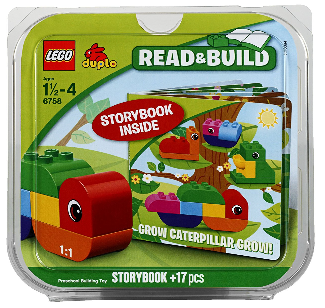 |
| A DUPLO construction set and matching board book. |
In the box: Storybook, 17 DUPLO pieces
DUPLOs and LEGOs are two of my all-time favorite construction toys and they are both made by the same company - The LEGO Group. DUPLOs and LEGOs are interlocking bricks that can be used to construct a model, taken apart, and used to construct something totally different. The replay value makes this one of the best toy values on the market, IMHO. And when you consider the skills that can all be addressed in one activity, you can see why they are a hit with therapists also.
DUPLOs are made for toddlers - large pieces that are easy to manipulate and too large to swallow. DUPLO models typically consist of only a few pieces and are meant to be played with once the models are complete.
The book that comes with this set tells the story of a caterpillar who starts out as a baby and wants to know what he will look like when he is grown. On each page he asks a different animal (frog, snail, beetle - see image above) if he will look like them. The book shows the different pieces necessary to build each animal and you assemble each one as you read through the book.
Something I really like about this particular set is that there are enough pieces included so that all the animals can be made at the same time, you do not have to disassemble some to put others together. Once the animals are all assembled you can act out the story or read through the book again.
Try this:
- Start with a few minutes of free play so that the child gets the feel of the pieces and how they snap together.
- Put only the pieces needed for the character you are making next to the individual for an easy start.
- Put all the pieces in a pile and ask the individual to find the pieces he needs to build each character. Turn some of the pieces upside down or on their side so the child will have to recognize them from different perspectives.
- Demonstrate how to assemble the object while the individual watches, then take the pieces apart and ask the individual to do it.
- Cover the layers of the animal you are building above where you are building if the individual cannot see what he should be looking at.
- Use the term "stack". I have worked with individuals that took a long time to learn the concept of starting from the bottom and building up, so I use the word stack and that has seemed to help. That and covering the pieces above the level where you are working.
- Take time for creative play at the end with the finished pieces.
- Work
on visual discrimination, visual closure, spatial relations/position in
space, manual dexterity, hand and finger strength, coordinated use of
both hands, eye-hand coordination, tactile perception, executive
function, process skills, creative play, play and leisure exploration
and participation





No comments:
Post a Comment
Thank you for taking the time to comment.